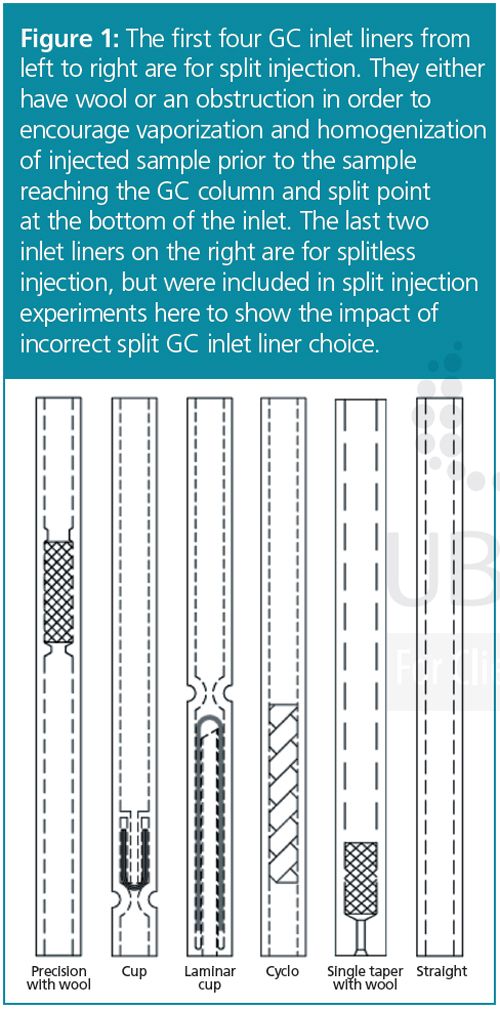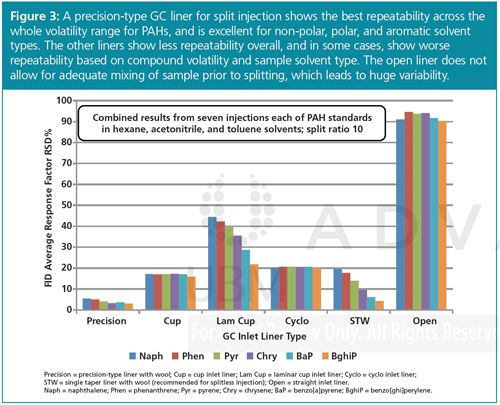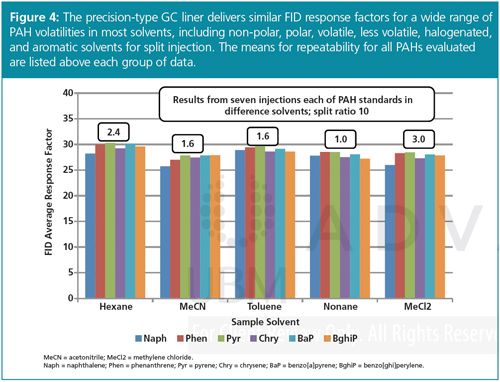Split Injection GC: Inlet Liner Choice for Shoot and Dilute GC
Jack Cochran’s new column “Practical GC” provides readers with practical advice and new experimental evidence for how to get the best results from their gas chromatography (GC) systems. The next instalment looks at GC inlet liner choice for “shoot and dilute” GC.
Photo Credit: Raj Kamal/Getty Images

Jack Cochran’s new column “Practical GC” provides readers with practical advice and new experimental evidence for how to get the best results from their gas chromatography (GC) systems. The next instalment looks at GC inlet liner choice for “shoot and dilute” GC.
In my previous article, I not only defined when split injection “has” to be done (for example, with highly concentrated samples so a gas chromatography [GC] column does not become overloaded), but I also demonstrated that split injection has practical use in trace-level GC when used with a modern, ultra-sensitive detector.
1
I also listed the numerous features and benefits of split injection, with a hope that users who are having problems with splitless injection might give split injection, or “shoot and dilute” GC a try. I want to list the merits of split injection again in case you missed the last piece: 1. Split injection introduces a very narrow band of sample to maintain GC column separation efficiency, which is particularly important for narrower bore GC columns (0.25 mm i.d. and less). 2. Split injection offers highly efficient and consistent transfer of a wide volatility range of compounds to the GC column. 3. Split injection allows a higher GC oven start temperature, which helps increase throughput. 4. Split injection eliminates peak splitting that occurs when using polar solvents with non-polar GC stationary phases (or non-polar solvents with polar GC phases). 5. Split injection increases GC column lifetime by decreasing the amount of non-volatile material that goes on the column with every dirty sample injection. 6. Split injection minimizes sensitive compound degradation by decreasing compound residence time in the hot GC inlet. 7. Split injection improves quantitative accuracy by reducing adsorption of active compounds to GC inlet liner surfaces. 8. Split injection reduces lower volatility compound-of-interest loss to inlet liner surfaces for samples that contain non-volatile material. If increasing throughput, eliminating peak splitting, and avoiding compound degradation are of interest to you, I invite you to review the split injection examples I presented in my first “Practical GC” article.
1

In the past, the development of liners for split injection revolved around the need for good sample homogenization before reaching the column entrance and split point at the bottom of the GC inlet. While inexpensive borosilicate glass wool provided an excellent homogenization/vaporization area for split injection, its adsorptive and catalytic activity compromised certain analyses. These concerns led to a slew of split liner offerings designed around providing a tortuous mixing path between points of injection and split, while avoiding the use of glass wool or other packing materials. Included (but not limited to) are the cup-type and cyclo- (or helix-) type split liners shown in Figure 1. While these split liners were designed with good principles in mind, based on the lack of current data demonstrating their advantages (if any), it could be argued that some have outlived their usefulness. This is especially true given the introduction of highly deactivated quartz wool packing for split liners. Unfortunately, once a liner makes it into a company’s catalogue, it is rarely discontinued, which is why new laboratory experiments are needed to help differentiate one split liner from another.
Experimental
A 30 m x 0.25 mm, 0.25-µm 5% diphenyl - 95% dimethyl polysiloxane GC column (Restek) with helium carrier gas at a constant flow of 1.4 mL/min was used for all experiments. The GC oven programme was as follows: 100 °C (0.1 min), 7 °C/min to 330 °C. The flame ionization detector (FID) (Agilent) was at 350 °C. Nitrogen makeup + column flow was at 50 mL/min. Fast 1 µL autosampler injections of standards containing 18 polycyclic aromatic hydrocarbons (PAHs) at 2 ng/µL each PAH were made into various liners used for either split or splitless GC (Figure 1). The split ratio was always 10. Six PAHs from volatile to involatile were used to define liner efficacy for split injection with a variety of different sample solvents spanning a range of volatility and polarity. Seven replicate injections of each PAH solvent standard were performed into the differing liners.
Results and Discussion
Generally speaking, split liner performance should be independent of compound volatility and solvent type, which in this case means the PAHs should show approximately the same FID average response factors and low RSD% values for replicate injections. Figure 2 is a summary of all the data collected for hexane, acetonitrile, and toluene solvents, and indicates the excellent average response factor performance for the precision-type liner. Laminar cup liner results are biased high and the single-taper-with-wool liner results indicate compound-volatility discrimination. The performance differences in favour of the precision-type liner become more obvious when viewing the repeatability results in Figure 3. Remember that the data represents a compilation of three solvent-types chosen for the work, which makes the very low RSD% values for the precision- (or focus-) type liner more impressive.


Readers may be wondering why a liner without mixing capability (straight/open liner) was included in this work. Uh, I am too... While an open liner can be used for split work where the sample is already a gas or vapour, it does not work well for liquid samples. The fast autosampler injection throws the sample liquid droplet past the column entrance to the split point, where sample exits prior to vaporization, leading to severely low response factors for all PAHs (Figure 2). Repeatability is also unacceptably poor for the straight liner when used for split injection with liquid samples (Figure 3). After deciding that the precision-type liner gives the best comprehensive split injection performance, a closer look should now be taken at average response factors and repeatability for specific solvent types (Figure 4). Both average response factor data and repeatability data indicate excellent consistency for the precision-type liner across compound- and solvent-types.

I am often asked by gas chromatographers, “Is there one liner I can use for all split and splitless GC work?” The single-taper-with-wool liner is sometimes touted as the universal split and splitless GC inlet liner because it has wool for good sample vaporization and homogenization, and the taper protects the sample from being lost to the metal bottom seal. However, the split injection data shown in Figure 5 for the single-taper-with-wool liner reveals discrimination effects for PAHs depending on the solvent type, and repeatability that is not as good as seen for the precision-type liner. Is it possible then that the precision-type liner is the universal liner for split and splitless GC? My answer is “no” for splitless injection, but data to back up that assertion will have to wait until later.

Given my suggestion in the previous “shoot and dilute GC” article to try the precision-type liner, fortunately for me and any readers who grabbed that liner and went to the laboratory, the data presented here validate its choice as an excellent split injection liner.
Reference
1. J. Cochran,
The Column
11
(21), 14–20 (2015).
Jack Cochran
is a Director of New Business and Technology at Restek Corporation. He is a recognized expert in GC and GC×GC for the analysis of pesticides and priority pollutants. He serves on the Board of Directors for FLAG Works (sponsor of NACRW) and the Centre of Oil and Gas Research and Development at the University of Manitoba. Jack is also an Adjunct Professor in the Forensic Science Program at The Pennsylvania State University.

Study Examines Impact of Zwitterionic Liquid Structures on Volatile Carboxylic Acid Separation in GC
March 28th 2025Iowa State University researchers evaluated imidazolium-based ZILs with sulfonate and triflimide anions to understand the influence of ZILs’ chemical structures on polar analyte separation.
Quantifying Microplastics in Meconium Samples Using Pyrolysis–GC-MS
March 26th 2025Using pyrolysis-gas chromatography and mass spectrometry, scientists from Fudan University and the Putuo District Center for Disease Control and Prevention detected and quantified microplastics in newborn stool samples.












